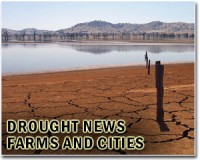| . |  |
. |
Lucknow, India (AFP) Sept 9, 2009 Drought-hit farmers in northern India are resorting to selling their wives to repay debts to local loan sharks, activists say, as one of the weakest monsoons in years takes its toll. Poverty, poor administration and a lack of education means farmers in the rugged Bundelkhand region are taking extreme steps to pull through a poor rainy season, they say. "This has been happening for quite some time now, but people were hesitant to come out with all this," said Manoj Kumar, a social activist working with farmers in the area. Excluded from the formal banking sector, the poverty-stricken farmers often turn to usurious private money lenders when banks refuse them loans or even accounts. After five years of poor crop yields and steadily decreasing rainfall, the crushing weight of the high interest payments has led to a well-documented spate of suicides and increasing cases of human-trafficking. Another social worker, Shailendra Sagar, said the situation of farmers in Bundelkhand, a region that spans the states of Uttar Pradesh and Madhya Pradesh, was "pathetic." "They are living in debt. Selling off one's wife or daughters is the last resort," he said. The sale price for married women is hard to ascertain and their fate after being sold is equally difficult to follow. Local reports have suggested wives can be pawned or sold for anything between one rupee to 12,000 rupees (240 dollars). Some women are sold under the guise of a legal marriage, complete with a formal contract, but activists believe others end up being exploited by prostitution rings. In the last four to five years around 50 percent of the region's population has left Bundelkhand villages to find work in cities, and at least 500 farmers have committed suicide, according to various Indian media reports. For India's 235 million farmers, a bad monsoon can spell financial disaster because of the lack of irrigation. Low rains have ravaged India's rice, cane sugar and groundnut crops, and have disrupted the flow of water into the main reservoirs that are vital for hydropower generation and winter irrigation. About 40 percent of India's districts have declared a drought, and the India Meteorological Department (IMD) this week said the country faced a 20-percent annual rainfall deficiency, though that figure is expected to improve with recent patchy rains. Ranjana Kumari, director of the Centre for Social Research in New Delhi, said research had identified Bundelkhand as one of the regions most vulnerable to sex trafficking. "This region is famous for that. Even earlier such incidents have happened, it's not the first time," she said. Some farmers are aware that they are selling their wives to prostitution rings, Kumari added, but "they do it out of absolute desperation. They have absolutely no other alternative before them." A government-funded scheme in which states are obliged to guarantee 100 days of paid employment per year to villagers has yet to be fully implemented in Bundelkhand. "There are no specially dedicated schemes to develop these regions. If skill training was delivered, this whole situation would have been different in the past six decades," said Kumari.
Share This Article With Planet Earth
Related Links Climate Science News - Modeling, Mitigation Adaptation
 President declares 'public calamity' as drought, famine worsen
President declares 'public calamity' as drought, famine worsenGuatemala City (AFP) Sept 9, 2009 Guatemala's President Alvaro Colom has declared a "public calamity" from drought and famine that have claimed more than 460 lives since the start of the year. "I have decided to declare a state of public calamity throughout the country," Colom declared in a nationally-broadcast address Tuesday. "This will allow us to have access to international aid resources and to mobilize resources ... read more |
|
| The content herein, unless otherwise known to be public domain, are Copyright 1995-2009 - SpaceDaily. AFP and UPI Wire Stories are copyright Agence France-Presse and United Press International. ESA Portal Reports are copyright European Space Agency. All NASA sourced material is public domain. Additional copyrights may apply in whole or part to other bona fide parties. Advertising does not imply endorsement,agreement or approval of any opinions, statements or information provided by SpaceDaily on any Web page published or hosted by SpaceDaily. Privacy Statement |